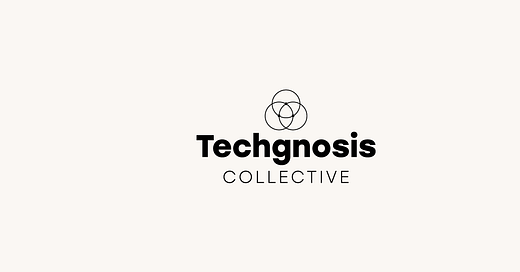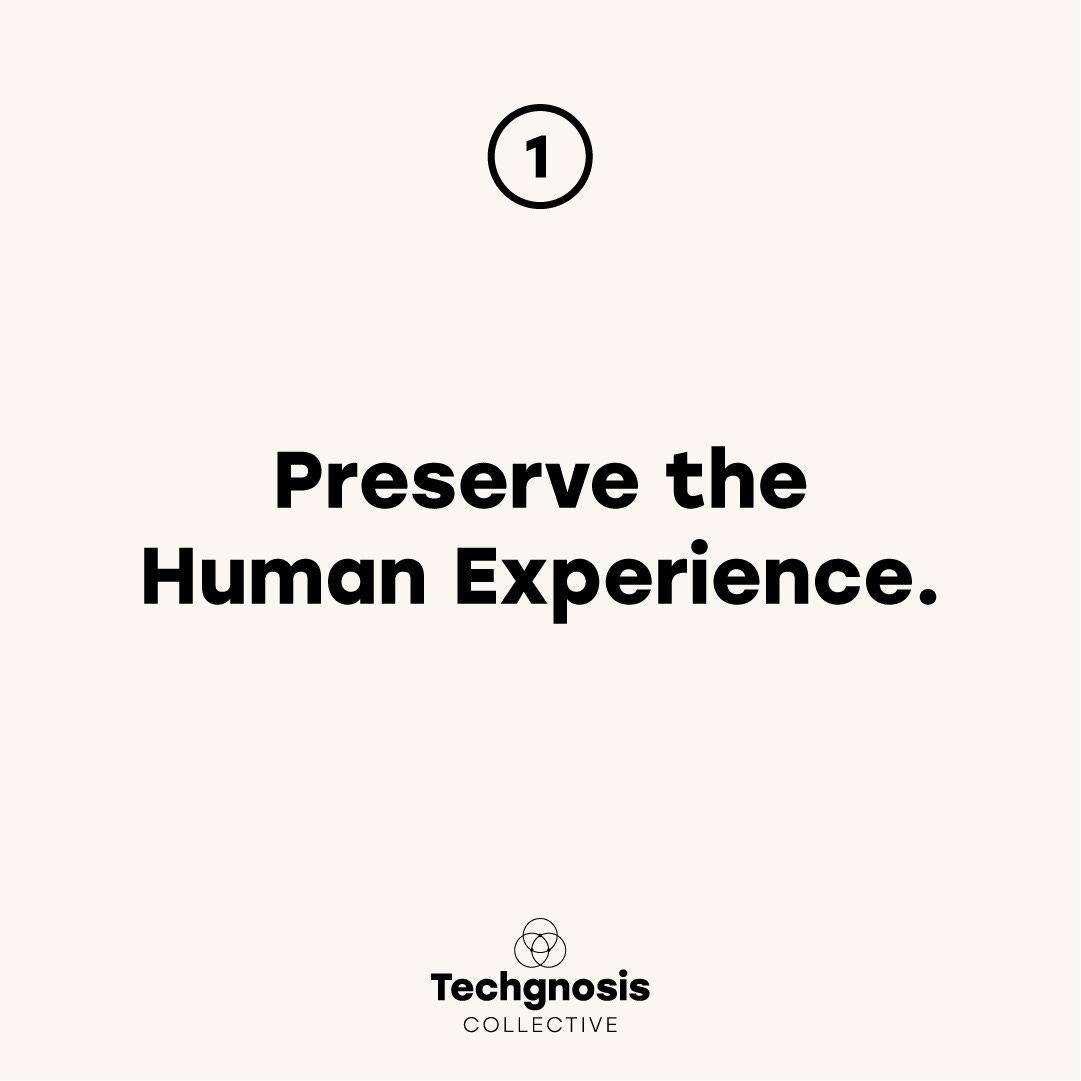Techgnosis Manifesto - 1. Preserve The Human Experience
Learn more about our upcoming community call & the first manifesto point
In the first Techgnosis Manifesto point, we write: “We refuse to let the pursuit of efficiency and convenience overshadow the richness of human experience.” We see the human experience as a phenomenon of rich, meaningful relations. But how does technology fit in? How do digital technologies shape our human experience?
As embodied beings in a technological world, we all share a network of meaningful paths towards being ourselves, or more appropriately, becoming ourselves. But what does it mean to become yourself in today’s digital age? What is the human experience, and what does it mean to preserve it in a techno-social context?
Welcome to another edition of the Techgnosis Newsletter, where we dive deeper into the question of the human experience, to collectively find understanding, meaning and humanness in the more-than-human world.
Join our first Online Community Call
We’re excited to invite you to the first-ever online community call of the Techgnosis Collective!
This is your chance to connect with like-minded individuals passionate about exploring the intersection of conscious digital navigation, spiritual practice, and preserving the human experience in our evolving, interconnected world.
Human-Technology-World Relations
Phenomenology is the study of subjective, conscious experience. Since the 90s, philosopher Don Ihde introduced postphenomenology, the study of our subjective experience related to technology. Ihde aims to move away from a classic phenomenological account of technology, often seen in a negative light. From technology as a transcendental, overarching concept towards a more empirical approach. Postphenomenology teaches us that subject/object relations are co-constitutive, where technologies act as mediators. Mediation is the source from which a certain subjectivity or objectivity arises. We gain diverse subjective experiences of the world depending on which technologies we use. If we look through a microscope, sit in front of a screen, or even wear glasses, our experience and relation to the world become mediated by these technologies. Ihde proposed four different human-technology-world relations.
The first type is what Ihde calls embodiment relations. Here, we as subjects merge with technology. Think of glasses. We see through the glasses and the glasses become seen through. So much, so that they become part of our embodiment. The relation here is denoted as [I-Glasses]-World.
The second type is hermeneutic, meaning interpretive. In this type, the technology references something beyond ourselves. When looking at a map, we not only see the map but also the world the map refers to. We interpret the information the technology gives to experience the world in a certain way. This relationship is denoted as I-[Map-World].
The third type is called alterity relations, meaning that technology here is seen as something other than ourselves. The technologies in this case are seen as having or creating a world of their own. When we interact with these technologies the world itself becomes opaque, making us disengage from the everyday world. The world moves into the background. Think of withdrawing cash from a banking machine or playing with a robot dog. The relation is denoted as I-Technology-[World].
The fourth type is background relations, written as I-[Technology]-World relations. The technology itself is something going on in the background, such as heating systems, traffic control systems, and so on.
Dutch philosopher Peter-Paul Verbeek introduced a fifth type, namely cyborg relations. Where technology merges with our bodies, changing the subjective experience more radically.
These different types of looking at our relationship with technology and the world offer a way to facilitate ethical considerations. The way technologies can alter relations with the body, our perception, or move into the background, has implications for the design and implementation of technology. With Ihde’s classification, we can bring to the foreground, and better understand, what is often concealed in our relations with technology.
Creativity And The Human Experience In The Digital Age
In an age of rapid technological advancements, we find many human-technology-world relations that may be socially disruptive, raise questions about our embodied human experience and make us wonder where the boundaries are. A diverse set of experiences and subjectivities depending on how and which technologies we use creates a more complex techno-social context than ever before. But throughout all these experiences, what is the core, the essence, of our human experience? If there even is one…
Whitehead, an influential philosopher, argues that the principle of creativity fits the best description of our reality as conscious beings in this layer of the universe. The source of all being, and of our human experience, is creativity. A sacred creative activity which makes everything exist. We are in a sense all creatures of creativity. It’s the attribute of an all-encompassing energy field or Consciousness with a capital C, which spontaneously generates novelty.
“The many become one, and are increased by one”
(Whitehead, Process and Reality, 20)
Preserving the human experience in the digital age means preserving this sacred act of creation via creativity. With technologies such as Generative AI, the human-AI-world relationship becomes a complex interplay where AI serves as a mediator transforming our human experience. However, what this inherently shows us is our true humaneness via conscious experience. We can be genuinely creative, actually interpret the world and gain profound insights into our relations with each other and our lived experiences. AI technologies can merely imitate this. They show us what machines can do, what machines can’t do, and therefore what makes us human. We are the ones with sentience. We are the ones co-creating the world together.
For example, ask ChatGPT if it can have a conscious experience.
ChatGPT clearly states it doesn’t have awareness, feelings or a sense of self. These attributes, following Whitehead’s philosophy, are generated by creativity. We are truly creative beings. We can feel, perceive, and become aware. We are on a path of becoming ourselves, becoming more human, by gaining an understanding of what we truly are in a techno-social context.
Of course, we need to stay mindful of the way we use digital technologies, specifically AI. As Marshall McLuhan said:
“Every extension of mankind, especially technological extensions, has the effect of amputating or modifying some other extension[…]”
(Marshall McLuhan, Understanding Media: The Extensions of Man : Critical Edition)
When using AI for certain tasks, it's important to avoid relying on it for our creative and emotional expression. AI should not replace our creative thinking or serve as a substitute for meaningful conversations where we share our feelings. To preserve the human experience, we must honour our imagination, creativity, and emotions.
Towards Awareness And Creativity
Human-AI-World relations show us how our subjectivity is coloured by awareness and creativity. But it is still our job to preserve this sacred act of creation. We shouldn’t let technologies and AI platforms make the big decisions for us. We are the ones who can shape the future through creative expression, we have the autonomy and moral obligation to remain humane via being aware of our inner worlds, and how this connects to the outer world.
What’s coming up next in this newsletter
In the coming newsletters, we’ll dive deeper into the next manifesto point “Harness Technology Mindfully”, further shaping our views and thoughts about the purpose and essence of this collective.
This is also a journey of exploration for us, nothing here is set in stone yet. We’re very curious to hear back from YOU the readers if something resonates, or if you have thoughts or ideas yourself that you think we could include or expand upon.





